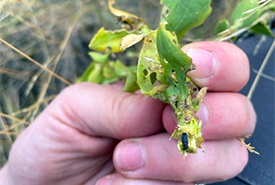Weeding with weevils
Using a beetle to control Dalmatian toadflax on an NCC property
Dalmatian toadflax damaged by weevil biocontrol (Photo by NCC)
Controlling invasive weeds might not seem like glamorous work, but it is a key part of managing natural areas that requires some out-of-the-box thinking.
The Nature Conservancy of Canada (NCC) works to protect incredible and important natural spaces across the country. But protecting new areas is only the first step in the conservation process. What follows is the management of the lands, which involves responding to many challenges.
One of the most time-consuming and costly is controlling invasive plant species. Otherwise known as weeds, these introduced plants establish and spread rapidly. They outcompete native plants, harming wildlife, ecosystems and economies.
“Conserving these landscapes for future generations doesn’t just involve limiting development; it also means keeping these landscapes pristine and native, which requires invasive species mitigation,” says Ayla Peacock, NCC invasive species technician with NCC in Alberta. “These invasives are harmful and very prolific, so if we want our beautiful landscapes to stay that way, this is essential work.”
Dozens of invasive plant species have been found at NCC properties across Alberta. Each species is unique, with different growth and reproductive strategies. They also vary in how they respond to control methods, which include pulling, mowing and herbicide application.
Way more than 101 Dalmatians
One of the most challenging invasive plants in Alberta is Dalmatian toadflax. This yellow-flowered perennial (it lives multiple years) plant originated from Eurasia. Unfortunately, it has made its way to a handful of NCC properties in the Castle-Crowsnest region of southwestern Alberta.
“Once this toadflax gets established in an area, it will completely colonize it,” says Ayla. “Then it’s difficult for anything else to go around it. If you find a site where there’s a big infestation, there’s pretty much nothing except it, and maybe a few introduced grasses, growing.”
Dalmatian toadflax is hard to control because of how it grows. The plant produces rhizomes, which are stems that grow underground out from the plant’s main stem.
If a rhizome is severed from the main plant, it can grow into another plant. That means pulling the plant can result in more young plants being produced, and causing more harm than good.
Rhizomes also make herbicides less effective, meaning more applications are required, which is costly and takes time.
With these options being less than ideal, property managers in the area looked to another option: biological control, which refers to the use of a living creature to control a pest species.
Enjoying this story? Sign up for our newsletter!
Tiny but effective
Enter the Dalmatian toadflax stem-boring weevil, a small beetle that is a voracious predator of Dalmatian toadflax.
Adult weevils feed on new leaves and buds of the plant, chewing large holes in the plant tissue, which negatively affects the plant’s health.
Then, adult female weevils excavate small holes on the toadflax stem, where they lay eggs. The plant responds with a swelling on its stem, and the larvae develop and feed here. The following spring, adult beetles emerge to continue their life cycle.
These actions hurt the toadflax. The adult beetles stop the plant’s growth and suppress its flower and seed production. And the larvae damage vascular tissue, reducing the plants growth and ability to withstand disturbances.
One of the most important considerations of using a biological control agent such as this weevil is ensuring they are specific to only the target species. The Dalmatian toadflax stem-boring weevil only preys upon Dalmatian toadflax, so no native plants growing nearby are harmed.
During the summer of 2022, Ayla visited a site where the weevils had been released to control the toadflax in 2020. The plants were devastated by the weevils — to the delight of Ayla.
“You can tell right away when they are working,” says Ayla. “All the plants that I looked at had damage — you could clearly see it on their leaves and stems. It was very exciting.”
But Ayla, a keen scientist, was most encouraged by the before and after data at the site. The density of the weed had reduced by half from the release in 2020 to monitoring the site in 2022; not only were the plants being harmed, there were also fewer in number.
The approach to pest management
Applying different approaches for various situations is the backbone of the modern approach to controlling invasive species, known as integrated pest management. For example, spraying weed patches with herbicide is effective, but it might only work for certain species in certain situations.
This means weed technicians like Ayla must be quick on their feet and adapt to new situations.
“You have to look at integrated pest management like a tool box,” says Ayla. “To get a job done, you need multiple tools; you can’t just rely on one.”
Want to help NCC control destructive invasives? Consider donating today!




